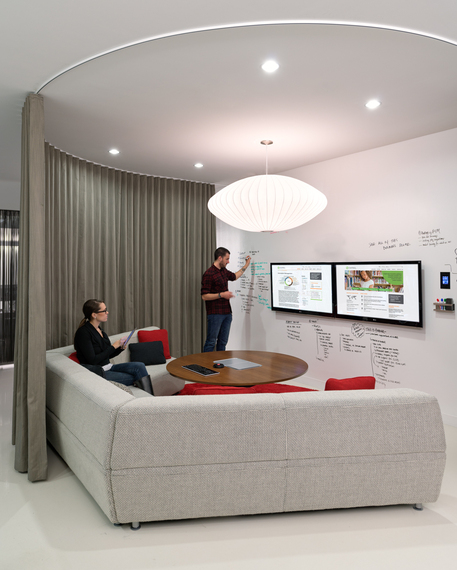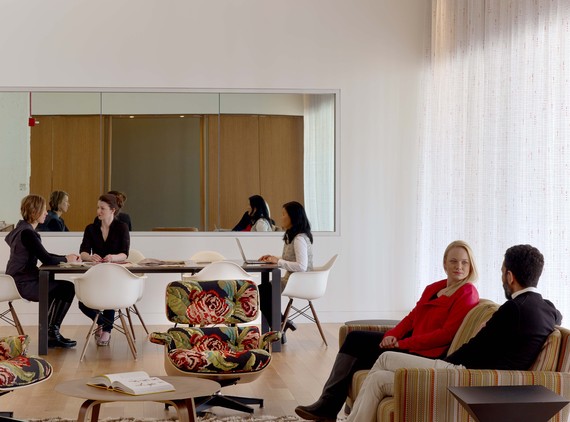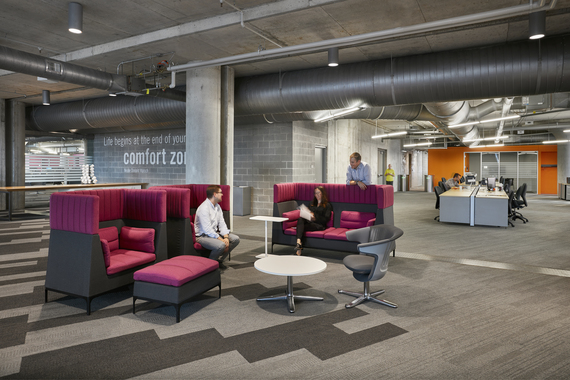Many workplace designers now cringe when they hear the word "collaboration" in reference to space planning. The term has become a ubiquitous catch-all description for so many things that it is quickly turning into a roll-your-eyes-when-you-hear-it buzzword. (Remember "out of the box?") Just as open office as a blanket solution is not an effective workplace strategy, "collaboration" does not fix all challenges. We've learned that too much teamwork can reduce one's ability to think alone and can have a negative effect on productivity, as evidenced by the market's response to its exhaustion with collaboration in Susan Cain's book in 2012, Quiet: The Power of Introverts in a World that Can't Stop Talking. Similar articles littered publications in droves in late 2014 and early 2015, like the Washington Post's Google Got it Wrong: How the Open Office Trend is Destroying the Workplace. So where does that leave us with collaboration?
Don Ricker is a workplace consultant and responsible for directing projects in the Chicago office of global design firm Gensler, who says, "Let me start by agreeing that collaboration has become a catch-all phrase for this idea that people should be working together, encouraging everyone to be social and get to know each other. They are supposed to do that by working together, but it doesn't have to be 'collaboration' in the traditional sense of the word. We have really stopped talking about collaboration as a thing unto itself, and instead, increased our focus on the outcomes of actually collaborating."
Typically, it is assumed that collaboration leads to better intrapersonal work relationships, better culture, and perhaps more innovation from one person's idea sparking another's. For the worker, the theoretical benefit is more friends at work and a more enjoyable and fulfilling work experience. For the company, the theoretical benefit is a better work culture that attracts, retains, and sustains better employees, as well as product or service innovation sparked by talented employees building off of one another's ideas. While this can be true, it is only true if used effectively and in moderation; not as the only solution. In this day and age, Americans want a one-size-fits-all magic pill, but as many of us can attest, workplace design doesn't work that way.
With the best intentions, we started creating environments that supported the idea that people should come together to work and socialize. It was a great concept at the outset, but somewhere along the way we got lost, arriving at the current "over-collaborized" state. Ricker says, "I can recall the earliest form of collaborations in the 90s, during the dot com boom. We started to see a shift of younger generations working and interacting simultaneously. Community spaces emerged in the work environment. Bean bag chairs entered the scene in the name of thinking and acting differently in the office. Then, foosball tables entered the office. This was all intended to be social activity and designed to build teams and make work fun, to create spaces for momentary daily escape; but if we look at what is happening now, social activity has gotten out of control with respect to collaboration. Work does not always have to be about being social, and we have to be sure there is time to be un-social and think, too."
Ricker continues, "After 2001, the dot com bust, we saw the concept of collaboration called into question for a while - as it attempted to be a lot of things to a lot of people. We saw the beanbag chairs and big community centers start to sprinkle into the open office, at times with seemingly random placement. It didn't work because of the openness: people felt exposed. Work culture still had not caught up to the idea of being open and free and sharing everything. It created distractions." What has happened since then is that technology, furniture providers, and designers have all been working on how to create that aspect of privacy in the open without putting up walls. Marker boards got taller and mobile. Furniture products became easily reconfigurable to adjust for visual privacy. Ricker says, "Now we are at a point where most office cultures are aligned with the concept of openness. It is expected that some are going to have a collaborative meeting over here or there. Technology has helped support this. People use headsets at their desk. Our mobile phones are also a music device. We are finding ways to distract ourselves from the distractions."
Perhaps one of the biggest challenges to figuring out the collaborative puzzle is that we are aiming for a moving target. In this day and age of knowledge work, the types of tasks a worker performs in a particular role - or even on any particular project - vary greatly. Many generations with very different work styles and expectations are working together under one roof. It is incredibly difficult to define what will or will not work because many people who will be working in these spaces may not know themselves.
Gensler relies on a workplace research team that has been developing proprietary Workplace Surveys for the last decade, unearthing insights that help design teams discover where to start. Ricker says, "At Gensler, we have a robust 'toolkit' in our arsenal of programs and processes that help us understand how people use space, so in addition to our research, our teams can steer effective alignment of clients' organizational goals to a well-informed design response. Our Workplace Index (WPI), for example, asks probing questions that take into account work culture and context, and how that affects what collaboration means in that workspace. In combination with our workplace survey results, our teams can merge observational research with trends and best practices to find the customized solution for each unique client."
Despite widespread fatigue with the term, collaboration itself is not bad. The visceral reaction to the word "collaboration" comes not from the concept itself, but from the gross overuse and misuse of what can be one very effective tool in the workplace toolkit. Perhaps instead of demonizing open office, collaboration, and the world built for extroverts, we should be seeking new ideas and formats that reinvigorate the concept as one part of a whole, and categorizing effective outcomes of working together, socializing together, and producing innovative results. As always, the most effective solutions strike a balance.
This article originally published in Business of Furniture on March 2, 2016 and can be found at this link.


